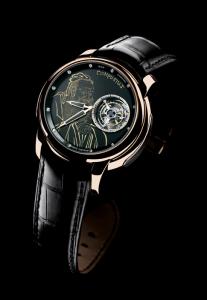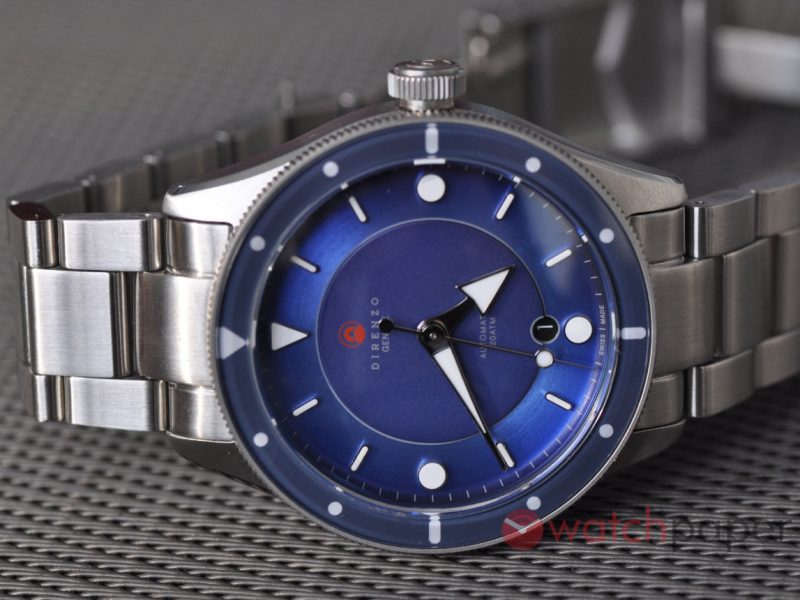JEAN DUNAND Tourbillon Orbital Confucius
The world of high complication watchmaking and belle horlogerie have married the technical expertise of a master watchmaker with the artistry of a miniaturist painter to produce a unique, one-off masterpiece. The mechanical prowess and poetry in motion of the gyrating tourbillon is enhanced with a miniature painting of sublime Oriental charm, an exceptional and highly original work of art.
Miniature painting is still practiced by an elite group of artisans, master craftsmen whose vir tuosity is still alive today in a tradition that can be traced to 14th century Persia. With the expansion of the Mongol Empire, the mastery of miniature painting spread to India and the powerful courts of the Mughal emperors. Mughal painting flourished in the mid-16th century with precious works of art whose colours and exquisite detail are still vibrant today.
In Europe miniature painting developed from the art of illuminating manuscripts and was practiced extensively throughout the Middle Ages. By the 1520’s the courts of France and England commissioned miniaturists to create portraits of their loved ones and following the flight of the Huguenots from France in the 17th century, the tradition of miniature painting found a new home in Geneva making its way onto watch dials and cases in the sumptuous tradition of haute horlogerie.
Jean Dunand, the Swiss artist whose work embodied the spirit of the Art Déco period and whose fascination and appreciation of Oriental art was made patent in his repertoire, is the inspiration and guiding light behind the Jean Dunand watch brand.
Jean Dunand’s passion for the Orient is recreated today in this miniature line portrait of Confucius, hand-painted on a very thin black onyx dial that has been inserted on top of a gold disk.
The Chinese philosopher, renowned for his teachings that revolved around the personal virtues of benevolence, charity, jen-humanity, reciprocity and the importance of ancestor worship, was born to a family of the lesser aristocracy in 551 B.C.
Confucius set about to bring order and peace to a divided nation of feudal states and following unsuccessful attempts to secure a patron, turned his attention to the teaching of young men. Following a fruitful and selfless life, Confucius died peacefully at the age of 72. Upon his death in 479 B.C., Master Kong, or Confucius, was buried just north of the city of Qufu and his disciples planted trees from all over China in his honour. The Kong Lin forest is the world’s oldest and largest private family cemetery and is the resting place for 76 generations of the Kong family, an amazing example of ancestral perpetuity that has never been matched by any other imperial or royal house.
Jean Dunand’s mechanical wonder celebrates the enduring Confucian legacy and has entrusted the meticulous travail of painting a miniature line portrait on the diminutive onyx surface to the capable hands of one single craftsman; the only artist in Switzerland capable of executing the demanding task. Countless hours of manual labour and fifteen kiln firings have been invested in this miniature.
The first challenge for Jean Dunand’s miniaturist is to reinterpret the original rectangular drawing onto the round surface of the onyx and a grid is used to plot the picture. Using top quality Swiss varnishes, the artisan blends his colour palette before undertaking the artistic odyssey where steady hands, keen eyes and patience are called upon, vital prerequisites that pay homage to the Confucian adage that “Impatience over little things introduces confusion into great schemes”.
Because of the delicacy and precision required, the artist handcrafts his paintbrushes from marten hair, often employing only a wisp of twenty odd hairs. Working from the face outwards with the aid of a binocular microscope, the ar tist applies the colours often repeating a stroke to increase volume that can be appreciated on Confucius’ beard or drawing out the stroke to achieve the nuance and gradation to render the curve of Confucius’ forehead.
Each painting session is followed by a stint in a 90-100° C kiln culminating in a final kiln firing of 6-7 hours.
The final result, a mere 3/100ths of a millimeter thick, is proof positive that complication and ornamentation, exceptional technology and consummate artistry do indeed produce remarkable results.



